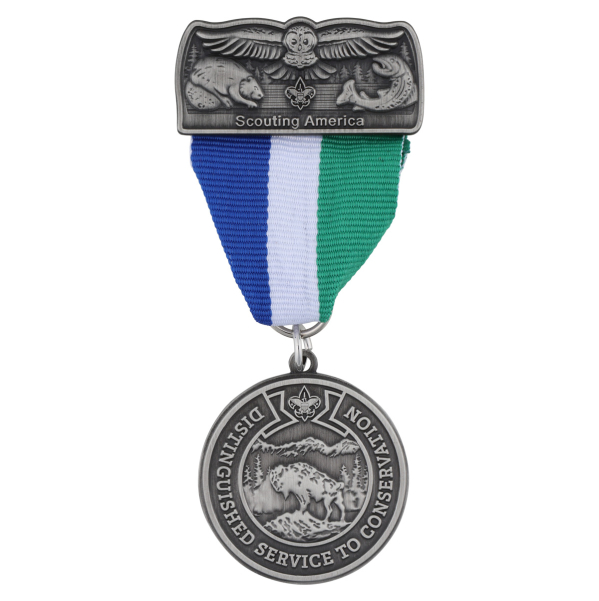Distinguished Conservation Service Award (DCSA)
Table of Contents
Introduction
The fundamental purpose of the Scouting America Distinguished Conservation Service Award (DCSA) is to encourage learning by the participants and to increase public awareness about natural resource conservation. Understanding and practicing sound stewardship of natural resources and environmental protection strengthens Scouting’s emphasis on respecting the outdoors. The goal of this awards program is to encourage and recognize truly outstanding efforts undertaken by Scouting units, Scouts and Venturers, adult Scouters, and other individuals, corporations, and institutions that have contributed significantly to natural resource conservation and environmental protection.
The DCSA is the most distinguished in Scouting for exceptional conservation service and is awarded for clearly outstanding efforts in planning, leadership, execution of plans, involvement of others, and opportunities taken to help others learn about natural resource conservation and environmental improvement.
The DCSA encourages and recognizes Scouts, Sea Scouts and Venturers who design, lead, and carry out conservation projects that are based on sound scientific principles and practices. The projects should contribute to sound conservation and environmental improvement in the local community, the region, or the nation. The applicant is expected to research potential projects and to choose, with guidance from a conservation adviser, a worthy project.
Conservation Service Projects
The DCSA encourages and recognizes Scouts, Sea Scouts and Venturers who design, lead, and carry out conservation projects that are based on sound scientific principles and practices. The projects should contribute to sound conservation and environmental improvement in the local community, the region, or the nation. The applicant is expected to research potential projects and to choose, with guidance from a conservation adviser, a worthy project.
Applicants for the Scouting America Distinguished Conservation Service Award must plan, lead, and carry out at least two significant projects in two different categories. One project could be the applicant’s Eagle Scout, Venturing Summit Award, or Sea Scout Quartermaster leadership service project, if it is suitable, and one could be performed on Scouting America property. The others must benefit a school, community, or religious organization, or fulfill some other public service purpose.
Projects Categories
- Energy conservation
- Soil and water conservation
- Fish and wildlife management
- Forestry and range management
- Air and water pollution control
- Resource recovery (recycling)
- Hazardous material disposal and management
- Invasive species control
- Pollinator Habitat Conservation
Monitoring
Each project should be designed in part to publicize the need to conserve natural resources and to improve environmental conditions.
The council is encouraged to provide guidance and to identify qualified advisers. The role of the conservation adviser is to guide the young person into selecting significant conservation projects and to coach the youth into preparing, researching, consulting others, designing, planning, and giving leadership to others in carrying out the projects. The adviser must approve the application, indicating that the applicant’s activities have been monitored and ensuring that the projects meet local needs. The applicant’s unit leader must also approve the conservation project.
Projects Qualifications
First and foremost, the project must be a conservation project—it must be designed to address a conservation issue or need in the local area, and it must benefit the environment or the creatures that live there. Making an area more accessible for people is rarely for the benefit of the environment.
How big a project should be and how long it should last are commonly asked questions.
Collecting aluminum cans over a weekend along with many other Scouts is a fine public service, but since little learning took place and there was no lasting impact on the community, the project would not qualify towards this Award. Similarly, a simple, one-time tree planting effort would not qualify.
However, a reforestation project in cooperation with a professional forester or park planner, learning which trees are appropriate to the area, ensuring proper spacing for best growth, following proper planting methods, and caring for the trees after planting might well qualify. Starting a community-wide recycling project and encouraging people to recycle might also qualify.
The size of the project is not necessarily the important element. Rather, the results, the learning that took place, the applicant’s demonstrated leadership, and the significance of the contribution to the community, park, or other lands are what count.
Award Requirements
Scouts BSA
- Be a First Class Scout.
- Earn the following five Merit Badges: Environmental Science, Fish and Wildlife Management, Forestry, Soil and Water Conservation, and
Sustainability. - Earn any two of the following Merit Badges: Bird Study, Energy, Fishing, Fly‐Fishing, Gardening, Geology, Insect Study, Landscape Architecture,
Mammal Study, Nature, Nuclear Science, Oceanography, Plant Science, Pulp and Paper, Reptile and Amphibian Study, or Weather. - Plan, lead and carry out two conservation projects, from two different categories The projects must be developed under the guidance and pre‐approval of the Scout’s Unit Leader, a Scouting America DCSA Adviser and the Council Conservation Committee. One of the projects may include the Scout’s Eagle Scout project, if applicable. All projects must contribute to environment improvement on a longterm scale. Applicants must use the Scouting America DCSA Workbook to document each of the service projects.
- Successfully pass a board of review conducted by the local Council’s Conservation Committee.
Scouting America has created an overview document that compares the Eagle Scout project and DCSA project workbooks, can it can be downloaded for review using the button below.
Venturing and Sea Scouts
- Plan, lead and carry out two conservation projects, from two different categories. The projects must be developed under the guidance of and pre‐approval by the applicants Unit Leader, a Scouting America DCSA Adviser and the Council Conservation Committee. One of the projects may include the Scout’s Venturing Summit Award, or Sea Scout Quartermaster project (if applicable). All projects must contribute to environment improvement on a long‐term scale. Applicants must use the Scouting America DCSA Workbook to document each of the service projects.
- Do both 2 (a) and (b):
(a) Make a tabletop display or presentation on one of your conservation projects for a crew, ship, post, a Cub Scout or Scouts BSA group, or another group.
(b) Submit an article about your project to a local newspaper, radio station, your school newspaper, internet publication, or TV station. - Lead a Cub Scout or Scouts BSA group in carrying out an age appropriate conservation project from a Scouting America DCSA project category.
- Write a paper or make a presentation on a plant or wildlife species. Include its value as seen from various perspectives, some of the problems various species face, and how we might be able to help.
- Do both 5 (a) and (b).
(a) Select an area approved by your Scouting America DCSA Adviser that contains several species of wildlife or plants. Observe this area thoroughly in various conditions and seasons of the year. Study the history of this area, paying attention to how it has changed over time, ownership, land use patterns, and landform and climate changes.
(b) Make a presentation on interaction between species; the reaction of various species to changes in conditions or outside influences; the degree to which this area provides food, shelter, materials, and protection for each species; population trends; your predictions on the future of these species; suggested actions to protect or enhance the populations; and the investigation methods that you used. - Do 6 (a) and (b):
(a) Study a specific plant or wildlife species approved by your Adviser that can be found in several different areas. Observe this species thoroughly in various areas and seasons of the year. Study the history of this species paying attention to how it has adapted over time.
(b) Make a presentation on this species; any reactions to changes in conditions or outside influences; this species’ needs for food, soil, shelter, materials, protection, assistance with propagation, etc.; population trends; your prediction for the future of this species; suggested actions to protect or enhance the population; and the investigation methods you used. - Explain the basic natural systems, cycles, and changes over time and how they are evidenced in a watershed near to where you live. Include the four basic elements, land use patterns, and at least six different species in your analysis and how they have changed over time. Discuss both biological and physical components.
- Describe at least four environmental study areas near where you live. Include the reasons for selecting these areas, their boundaries, user groups, past inventories, any outside forces that interact with them, and a list of what things could be studied at each of them.
- Plan a field trip to each of the above areas, including detailed plans for consolidating various investigations. Follow all the requirements such as landowner permissions and/or needed permits, safety plans, transportation plans, equipment needs, etc.
- Do 10 (a) and (b):
(a) Under the guidance of a natural resource professional, carry out an investigation of an ecological subject approved by your Scouting America DCSA Adviser in one of the areas selected above. Inventory and map the area. Conduct a detailed investigation providing specific data for a specific topic.
(b) Document and present your findings to a crew, ship, post, pack, troop, or another group. - Teach others in a crew, ship, post, pack, troop, or another group how to carry out an ecological investigation. Use steps 9 and 10 above with the group so that they may also learn by doing.
- Successfully pass a board of review conducted by the local Council’s Conservation Committee.
Award Process
Step
Resources
Applicant learns about the Distinguished Conservation Service Award (DCSA).
- Develops plans to earn necessary merit badges needed (for Scouts BSA) or requirements (for Venturers and Sea Scouts).
- Starts working on identifying potential projects.
- Applicant obtains DCSA Project Workbook and familiarizes them self with it.
Applicant receives support from local resources.
- Applicant is connected to Council Conservation Committee/Representative.
- Applicant is connected with trained DCSA Adviser.
- Applicant identifies project or area of focus for project.
- Applicant connected to local conservation organization for assistance.
- Applicant identifies Project Conservation Adviser (usually part of the Benefiting Organization).
Applicant begins research process.
- Applicant researches potential projects/areas of interest.
- Applicant works with Project Conservation Adviser on proposal.
- Applicant gets input from DCSA Adviser.
- Applicant gets project support from Benefiting Organization.
- Application should complete an Executive Summary of the project using the template provided.
The Conservation Committee will use the Project Proposal Evaluation Document to asses the project proposal that can be downloaded for review:
Applicant starts on preliminary work.
- Applicant begins collecting critical pre-work documentation.
- Applicant completes project workbook pages 6–15.
- Applicant gets project approval from Conservation Adviser, Benefiting Organization, DCSA Adviser, and Council Conservation Committee.
- Applicant incorporates suggestions and completes project workbook pages 17-33 in collaboration with the Conservation Adviser.
The Conservation Committee will use the Project Plan Evaluation Document to asses the project plan that can be downloaded for review:
Applicant starts on conservation project 1.
- Applicant carries out project and documents all time spent and materials utilized.
- Applicant fills out project workbook pages 34-39 at completion of project.
- Applicant completes post-work documentation for impact.
Be sure to document EVERYTHING and include supporting materials such as site visits, notes, photographs, drawings, articles, letters, etc.
Applicant repeats process for conservation project 2.
- Repeat steps 2-5 above in a new project workbook.
- Projects can be done concurrently.
Applicant completes evaluation procedure.
- Applicant completes merit badges needed (for Scouts BSA) or requirements (for Venturers and Sea Scouts).
- Applicant completes both project workbooks.
- Applicant completes the DCSA Application.
- Applicant obtains all needed signatures on both project workbooks and the DSCA Application.
- Applicant goes requests a Board of Review by the Council Conservation Committee (or designee).
Applicant goes through Board of Review process by Council Conservation Committee (or designee).
- Review the Board of Review Checklist to verify that all necessary workbooks, documents, supporting information, forms, letters, etc. have been completed.

